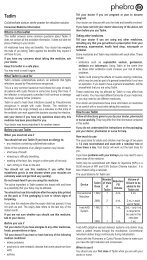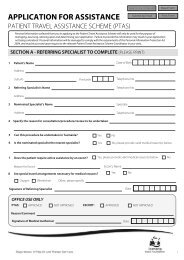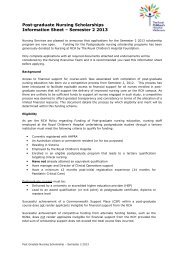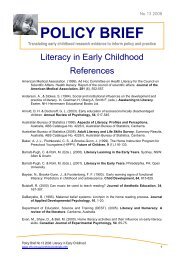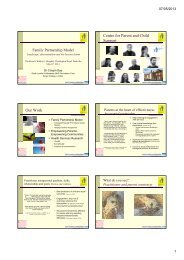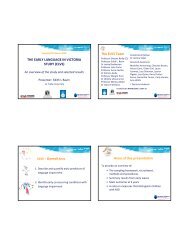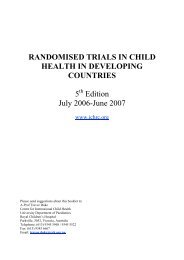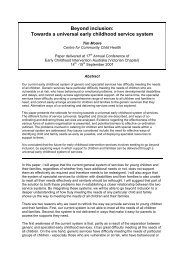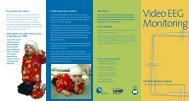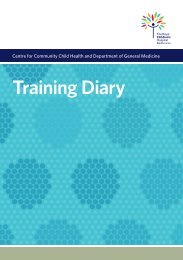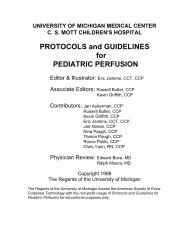Understanding Brachial Plexus Palsy - The Royal Children's Hospital
Understanding Brachial Plexus Palsy - The Royal Children's Hospital
Understanding Brachial Plexus Palsy - The Royal Children's Hospital
You also want an ePaper? Increase the reach of your titles
YUMPU automatically turns print PDFs into web optimized ePapers that Google loves.
Obstetrical brachial plexus injuries: glossary of terms<br />
Abduction<br />
Adduction<br />
Avulsion<br />
<strong>Brachial</strong> <strong>Plexus</strong><br />
Clavicle<br />
Contracture<br />
Dislocation<br />
Dystocia<br />
Erb’s <strong>Palsy</strong><br />
Extension<br />
External Rotation<br />
Flexion<br />
Horner’s Syndrome<br />
Humerus<br />
Internal Rotation<br />
A movement of the shoulder where the arm moves out to the side, away from the body.<br />
A movement of the shoulder where the arm moves in towards the body.<br />
When a nerve is disconnected from the spinal cord; no recovery is expected. At present it is not<br />
possible to surgically repair the nerve back into the spinal cord.<br />
<strong>Brachial</strong> refers to the arm; plexus means network. <strong>The</strong> brachial plexus is the name given to the network<br />
of nerves that provide movement and feeling to the arm. It is made up of five nerve roots (C5, C6, C7,<br />
C8 & T1) that exit the spinal cord and travel between the bones (vertebrae) of the spine. <strong>The</strong> nerves are<br />
called C5, C6, C7, C8 and T1. ‘C’ stands for cervical (neck), ‘T’ stands for thoracic (chest) and the<br />
number tells you which spinal cord segment the nerve comes from.<br />
Also called the collarbone; an elongated, slender bone running horizontally at the root of the neck,<br />
in the upper part of the chest.<br />
Shortening of muscles, tendons and ligaments about joints causing stiffness and limitation<br />
of movement.<br />
Displacement of a bone from a joint, eg. shoulder dislocation occurs when the upper arm bone<br />
(humerus) comes out of the shoulder joint.<br />
Pathologic or difficult labour, which can be caused by an obstruction or constriction of the birth<br />
passage or an abnormal size, shape, position or condition of the foetus.<br />
This is the name given to the injury when only the first 2 or 3 (C5, C6 +/- C7) of the five nerves that<br />
make up the brachial plexus are injured. This usually results in paralysis of the shoulder and elbow<br />
muscles. This is the most common type of brachial plexus injury at birth.<br />
In the upper limb, the shoulder, elbow, wrist and small joints of the fingers all move into extension.<br />
Extension is the straightening out of a joint.<br />
A movement of the shoulder which turns the arm out away from the body. It is this movement which<br />
is the most difficult for a baby with a brachial plexus injury. This movement is required when bringing<br />
your hand to your mouth, for example.<br />
In the upper limb, the shoulder, elbow, wrist and small joints in the fingers all move into flexion.<br />
Flexion is the opposite of extension, ie. bending the joint.<br />
Caused when the T1 nerve root of the brachial plexus is injured. It is characterised by drooping of the<br />
eyelid and a slightly smaller pupil on the same side as the brachial plexus injury.<br />
<strong>The</strong> bone of the upper arm, between the shoulder and elbow.<br />
A movement of the shoulder which turns the arm in towards the body. This movement is used when<br />
bringing your hand behind your back or when bringing your hand towards your opposite shoulder,<br />
for example. It is the muscles that produce the movement of internal rotation, which are most at risk<br />
of tightening up and forming contractures. <strong>The</strong>refore these muscles need to be stretched regularly and<br />
these range of movement exercises will be taught to you by your physiotherapist.<br />
18




